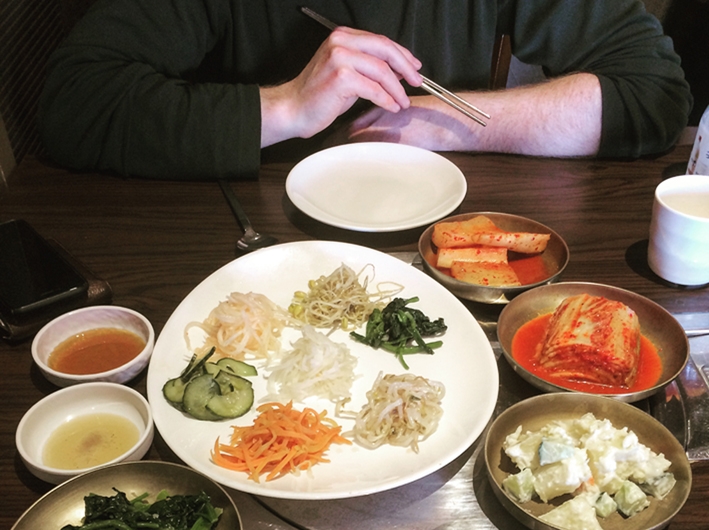About two months ago, T and I went to Southwest London’s K-Town (otherwise known as New Malden, an area that has one of the largest communities of expat Koreans in Europe) in search of pickles. As we were exploring our way through plates of assorted preserved vegetables, with staff and fellow diners eyeing our particular menu choices, one thing became awkwardly clear: that I knew very little about Korean food etiquette. I decided to begin my education by learning to make kimchi, the Korean staple of fermented vegetables, a process that not only led to a recipe but also to finding out about Korean culture and history.
In 2013, gimjang, the autumnal kimchi-making season in Korea, was listed as a UNESCO Intangible Cultural Heritage. It is a social practice that is passed from generation to generation, recreated and reinforced by communities, and as a national dish, kimchi is really important to Korean culture, history and identity. But gimjang is more than about making a popular food item. This annual event is about humans living in harmony with nature: the different components (shrimp, anchovies, salt, chilli and vegetables) are gathered throughout the year, and when late autumn arrives, whole communities will collectively prepare and ferment massive quantities to make sure every family is sustained through the winter. It’s about families coming together to learn from each other, share knowledge and strengthen bonds. And kimchi, the product of this hard work, transcends class boundaries – a humble and unifying element of Korean culture.
The single daily meal of ‘a handful of rice, half a bowl of soup and a few shreds of kimchi’ shared between two prisoners does the opposite of bringing people together
Food offers immediate access to a different culture through an introduction to new flavours, but the more nuanced and subtle tastes, sentiments and aesthetic sensibilities of a place and people can be found in their literature. And so, leaving the freshly made and rather pungent kimchi in the fridge, I read Han Kang’s Human Acts (first published in 2014 and translated into English by Deborah Smith in 2016). In this piece of literary nonfiction, which centres on the events of the 1980 Gwangju Uprising and the resulting massacre of civilians, the modest fermented vegetables make a brief appearance in the fourth chapter. The single daily meal of ‘a handful of rice, half a bowl of soup and a few shreds of kimchi’ shared between two prisoners does the opposite of bringing people together. Instead, the unnamed prisoner that the narrative of this particular chapter follows, who has been repeatedly beaten and tortured, reduced to a ‘brute animal’ – later, ‘a lump of meat’ – cannot bear to share the meagre rations with his ‘partner’: ‘I stared with open hatred at any morsel that passed his lips… those cold empty eyes, utterly devoid of… humanity. Just like my own,’ he says. This episode alone, featuring the most basic human instinct to eat, is a powerful comment on the unstable and conflicted political and social climate of Korea at that time, during Chun Doo-hwan’s military coup d’état and eventual rise to presidential power. Kimchi does not appear again in the book.
In 1995 the Gwangju Biennale was established to commemorate the victims of the pro-democracy Gwangju Uprising, with the first edition, Beyond the Borders, dedicated to transcending ‘divisions between ideologies, territories, religion, race, culture, humanity, and the arts’. The biennale also happened to be the first international arts event of its kind in Korea, which led to global recognition of the growing contemporary Korean arts scene. The 2016 publication of Human Acts coincides with the 11th edition of the Gwangju Biennale, of which ArtReview columnist Maria Lind is this year’s artistic director. In the forthcoming Autumn issue of ArtReview Asia she discusses the role that the biennale plays within the historical and political context of the city and how the latter is still an important anchor in curating the event (you can read her interview ahead of publication here).
Taking place at the same time in Korea are two other major biennials: SeMA Media City in Seoul and Busan Biennale. Curiously enough, these well-timed events across the country appear to triangulate harmoniously with one another, sharing contemporary art between the industry itself, but more importantly, with Korea and its people, drawing visitors from all over the country.
Is it a coincidence, then, that these biennials take place during this particular season? That each focuses on themes of history, identity, memory and our relationship with nature? I have only one answer: gimjang.
The Gwangju Biennale runs from 2 September through 11 November 2016
SeMA Media City, Seoul runs from 1 September through 20 November 2016
The Busan Biennial runs from 3 September through 30 November 2016
ArtReview Asia online exclusive published 25 August 2016.
